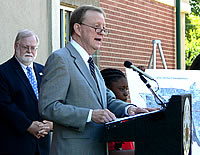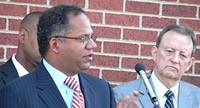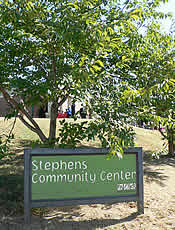Promise Neighborhood Partners Pledge Commitment to the Project
Representatives of six Little Rock organizational partners pledged to work together to help break the cycle of generational poverty with the launch of the Central Little Rock Promise Neighborhood (CLRPN).

More photos on Flickr.
The partners convened publicly for the first time to discuss their roles in the project, which will begin officially in October.
“It takes this kind of partnership… not a single approach,” City Board Director Ken Richardson said as the partners gathered outside Stephens Community Center to sign their promises. “We need more people singing from the same hymnal to arrest the cradle-to-prison pipeline and replace it with a cradle-to-college and career pipeline.”
That is exactly what the initiative aims to do. Last week, the U.S. Department of Education chose the Little Rock partners to receive a $430,000 grant to create a coordinated system of cradle-to-career services to improve educational outcomes and life prospects of low-income children.
 “A new season is beginning today,” UALR Chancellor Joel Anderson said of the project that is part of a bold new initiative that is sweeping the country providing comprehensive support for children and their families. “Little Rock is now poised to serve as a national model for improving educational and developmental outcomes for children in high-poverty neighborhoods.”
“A new season is beginning today,” UALR Chancellor Joel Anderson said of the project that is part of a bold new initiative that is sweeping the country providing comprehensive support for children and their families. “Little Rock is now poised to serve as a national model for improving educational and developmental outcomes for children in high-poverty neighborhoods.”
Partners in the project include the City of Little Rock, Little Rock School District, the Central Arkansas Library System, Arkansas Children’s Hospital, New Futures for Youth, and UALR, the lead agency.
In addition to a commitment to take an active role in the planning process to launch the Central Little Rock Promise Neighborhood, partnering agencies made these promises:
Arkansas Children’s Hospital: Clinical program services will be offered to children and youth in the target neighborhood, including primary medical care, specialty clinic services, and in-patient care, regardless of the family’s ability to pay, plus wellness, safety, and health promotion programming to the five neighborhood schools. ACH Executive Vice President Scott Gordon promised injury prevention outreaches and health literacy for kids from kindergarten to 12 grade to help children make better health choices. “We will be an engaged partner to make things happen,” he said.
Central Arkansas Library System: CALS is building a new Children and Youth Library and Learning Center in the heart of the Promise Neighborhood to provide learning enrichment opportunities for the children, youth, and families in Little Rock, with ready access and special programming for families in the neighborhood. The center will help children and young people graduate from high school and prepare for meaningful jobs and ongoing education. “Partnerships are hard, but we didn’t get in this hole overnight,” said CALS Director Bobby Roberts. “But with a lot of thinking, work, and cooperation, I am convinced we can go forward.” He pledged the library system’s help in providing safe after-school and summer places for children to learn.
City of Little Rock: In addition to a $50,000 match to support the Promise Neighborhood planning efforts, the city of Little Rock has committed to  marshaling resources in the targeted area, such as its job corps program, and to provide staff assistance from the City Manager’s Office, Little Rock Police Department, Department of Community Programs, Neighborhood and Housing, Workforce Investment Board, and Public Relations. “Today is about an opportunity to focus on the most important resources of our city, our children,” said City Manager Bruce Moore.
marshaling resources in the targeted area, such as its job corps program, and to provide staff assistance from the City Manager’s Office, Little Rock Police Department, Department of Community Programs, Neighborhood and Housing, Workforce Investment Board, and Public Relations. “Today is about an opportunity to focus on the most important resources of our city, our children,” said City Manager Bruce Moore.
Little Rock School District: LRSD will commit a lead administration team to participate in the school reform efforts and data collection process for the project research. Associate Superintendent Sadie Mitchell promised a “whatever it takes” attitude to make the program successful. “If not this block, which block?” she asked. “If not this day, which day? Today is the day we can and will change a community and change a city.”
 New Futures for Youth: The agency will assist with convening planning participants from the area and provide staff assistance, evaluation, and implementation information regarding key out-of-school time interventions including the Youth Initiative Project, Youth Intervention Specialists, and Youth Program Quality Assessment. “This is a remarkable partnership,” he said. “There is great promise in this neighborhood.”
New Futures for Youth: The agency will assist with convening planning participants from the area and provide staff assistance, evaluation, and implementation information regarding key out-of-school time interventions including the Youth Initiative Project, Youth Intervention Specialists, and Youth Program Quality Assessment. “This is a remarkable partnership,” he said. “There is great promise in this neighborhood.”
UALR: As lead partner, UALR will coordinate all aspects of the project, including the creation of a comprehensive data system capable of tracking a multitude of educational, health, family, and community support indicators for the up to 10,000 children in the neighborhood and the development of a financial strategy that will allow this project to be sustained over a number of years, once implemented. Results of the CLRPN efforts will be reported to the community in a series of town hall meetings that will culminate in a State of Our Kids Summit.
 “At this early time in the project, it’s difficult even for the partners to convey what a challenge this presents and the enormity of a long-term commitment of at least 20 years,” said Julie Hall, director of UALR’s University District Educational Network. “We have this unprecedented opportunity to lift our aspirations higher than ever before and change the options for the children growing up in poverty. I can’t wait to get started.”
“At this early time in the project, it’s difficult even for the partners to convey what a challenge this presents and the enormity of a long-term commitment of at least 20 years,” said Julie Hall, director of UALR’s University District Educational Network. “We have this unprecedented opportunity to lift our aspirations higher than ever before and change the options for the children growing up in poverty. I can’t wait to get started.”
The Central Little Rock Promise Neighborhood is bounded by Interstate 630 on the north, Boyle Park on the west, Fourche Creek Bottoms on the south, and Martin Luther King Drive on the east. Schools in the district are Bale, Franklin, and Stephens elementary schools; Forest Heights Middle School; and Hall High School.
The start-up grant will give UALR and its partners a year to prepare for the full-scale implementation of a program aimed at replicating the kind of private-public partnerships that made the Harlem Children’s Zone a model to provide children in the neighborhood “whatever it takes” to raise them up from babyhood to college.
The federal Promise Neighborhoods planning grants of up to $500,000 will support the work in a diverse set of communities in major metropolitan areas, small and medium-size cities, rural areas, and one Indian reservation. President Barack Obama Barack has requested $210 million in his fiscal 2011 budget, including $200 million to support implementation of Promise Neighborhood projects and $10 million for planning grants for new communities.
To address the challenges faced by students living in communities of concentrated poverty, Promise Neighborhoods grantees and their partner organizations will plan to provide services from early learning to college and career, including programs to improve the health, safety, and stability of neighborhoods, and boost family engagement in student learning.